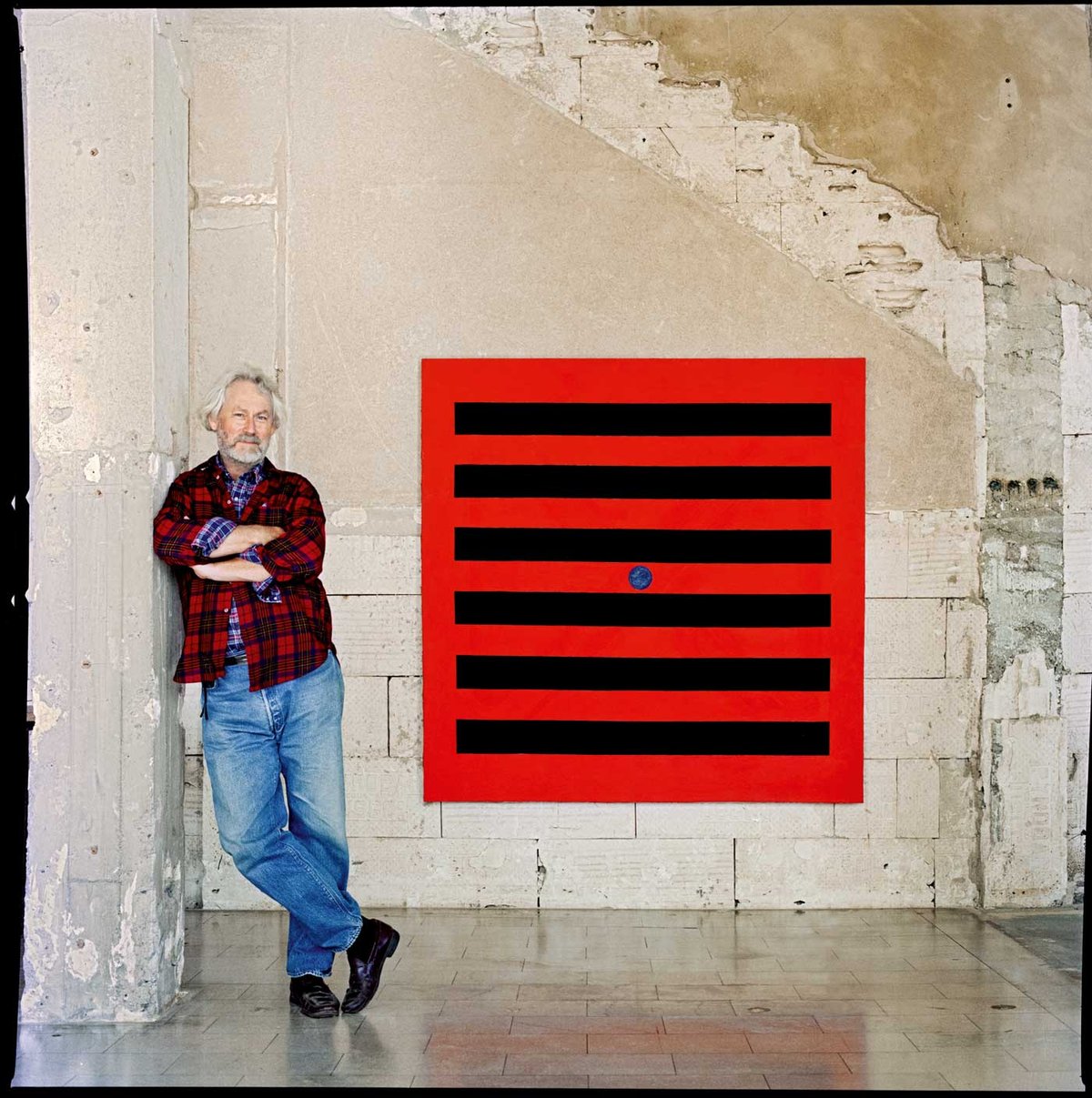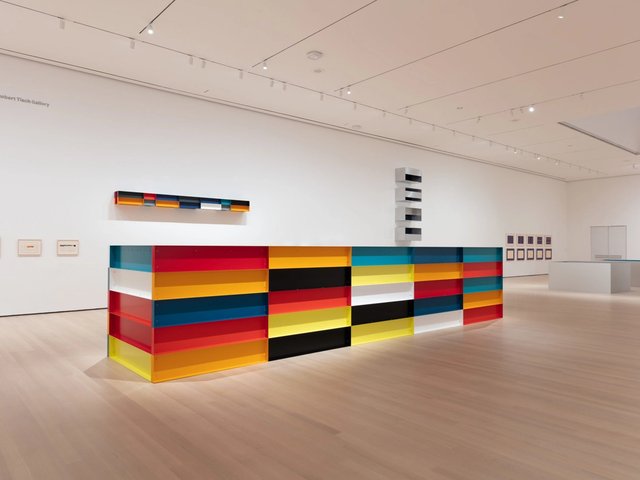“The complexity of Judd’s work’s making and meaning, its physicality and structure can be experienced in no other way than in person. Thus it will continue, far into the future to issue its challenge to museums, to their staffs and their publics,” the Museum of Modern Art (MoMA) curator Ann Temkin writes in her Donald Judd retrospective catalogue.
Judd was so bruised by his early museum exposure, the envy of many other artists, that he took to making custom crates to protect his work in transit. “Once his works entered the public realm,” Temkin writes, “their flat tops and boxlike forms were often read as invitations to rest an elbow or set down a purse. Their rectilinear structures tempted children and adults alike… to squish their bodies between the elements of a wall progression, climb inside a channel piece, or crouch beneath a single stack. Unbeknown to most visitors, the surfaces of the materials they were touching – Plexiglas, aluminium, galvanized iron—were as fragile as parchment and often irreparable.”
The curatorial pressures of presenting Judd at MoMA, all capably managed, could be keenly felt by visitors in the first two—and, to date, the only—weeks of its run: the difficulty of choosing works, of spacing and grouping them, and of securing them. But MoMA has never before reckoned with a challenge like that of the coronavirus (Covid-19) pandemic, which forced the institution’s and the show’s closing to the public indefinitely.
Anyone who confronts Judd’s art in person senses the inadequacy of even the most accurate photographic or video record to do more than tease memory. Yet the current global public health crisis has lent unanticipated interest to MoMA’s exhibition catalogue and to two other recent books honouring the artist and celebrating his self-set imperative to give “as much thought to placing as making art,” as Christine Mehring writes in the MoMA volume, not merely within a room but in the world.
Anyone who confronts Judd’s art in person senses the inadequacy of even the most accurate photographic or video record to do more than tease memory
Judd’s first practical move in that direction was his purchase in 1968 of a disused cast-iron building at 101 Spring Street in New York’s Lower Manhattan. It cost him $68,000, equivalent to more than $500,000 today. He moved his family into what was then mostly raw space and spent years renovating the five-storey interior as studio and living space. The building remained his New York base of operations even after he began spending months each year in Texas, beginning in 1973.
In 2013, nearly 20 years after Judd’s death, the Judd Foundation opened 101 Spring Street to visitors, impressively restored, with art re-installed as Judd’s will specified. (It was also closed indefinitely due to the health crisis.)
“Originally I wanted to live and work among a moderate amount of my work and of other people’s,” Judd wrote in a 1978 statement quoted in Donald Judd Spaces, a new Judd Foundation publication that documents his living and work spaces in New York and Texas. “Later I wanted much more of my work to look at and think about. Gradually a ratio developed between the work I kept and installed and that I exhibited and sold. In addition to seeing the work, it became obvious after several exhibitions that the work had to be defended by permanent installations.”
Donald Judd Spaces shines in some respects, especially in its photographic record of 101 Spring Street in various stages of renovation and use by the artist. It also enriches our view of the sensitive architectural interventions Judd made, from 1978 on, in and near the forlorn West Texas town of Marfa, as he arranged permanent sites there for his own and others’ work. It also usefully collects some of the most clarifying of Judd’s written statements on his creation of fixed settings for some of the contemporary art, in addition to his own, that mattered most to him. But as a pictorial record of Judd’s own and others’ work in Marfa the new book cannot compare with Chinati: The Vision of Donald Judd (2010), authored principally by the former Chinati Foundation director Marianne Stockebrand.
“Somewhere a portion of contemporary art has to exist as an example of what the art and its context were intended to be. Somewhere… a strict measure must exist for the art of this time and place,” Judd wrote in 1987. The Chinati complex in Marfa realised that dream.
The MoMA catalogue includes fascinating discussions with Judd’s former assistants regarding his work habits and decision-making. In it, Jamie Dearing explains the artist’s worldwide search for an enclave site empty and affordable enough to realise his vision of large, permanent art ensembles. “He made a… transparent circle,” Dearing recalls, “that represented 500 miles, I think… to try and find an area that big that had the fewest number of people in it…” Remembering that he had passed through Marfa in the late 1940s as an army recruit, Judd put the circle over Marfa and “it met all [his] criteria. It had the square mileage. Nothing was next to it. Very few people per square mile.”
“To me it’s not the middle of nowhere,” Judd said of Marfa to a European interviewer in 1990, “it’s the centre of the world…”.
West Texas boasts boundless space and a merciless sun that seems to carve light and shadow into distinct temporal frames, allowing Judd’s work installed there to register passing time with a clarity and nuance available almost nowhere in a museum setting.
Donald Judd Spaces gives revealing attention to land and buildings in and around Marfa that Judd bought and restored for his own use, rather than for public access. But most of its pages, with double spread, full-bleed images, are un-numbered, and captions, as Judd the designer might have preferred, appear only as back matter.
The books under review will offer divergent experiences to readers who witnessed the ascent of Judd’s career (he died in 1994) and those who did not. MoMA catalogue essays by Annie Ochmarek and Yasmil Raymond detail Judd’s demanding but highly productive relationships with metal fabricators in New York, Connecticut and Switzerland. Many readers will find Raymond’s account of Judd’s late works in colour most informative.
Yet neither Donald Judd Spaces, nor MoMA’s Judd contains a life chronology. Readers who want to track Judd’s biography in detail will only find it threaded through the essays in Judd and through the numerous conversations recorded and reported in Donald Judd Interviews, co-published by the Judd Foundation and David Zwirner.
About the size, shape and weight of a brick, like Donald Judd Writings, its 2016 companion volume, Donald Judd Interviews contains more than 800 pages of text and an appendix of images in black and white and colour. The interviews, dated between 1964 and 1993, record a spectrum of the artist’s attitudes, moods, recognition and facility at communicating his thinking. Certain questions arise repeatedly, among the most persistent: why he scorned the term “minimalism”, why he denounced the post-1960s art world, why he refused to call his work sculpture, and whether, after he had published much criticism in his youth, his art reacted against the common culture.
To the latter question he replied in 1967, “Not really; the reaction might be that 99% of the usual environment’s a total failure. So it might be a reaction to that, but not to complexity or clutter or anything like that. It‘s just that most of what you see doesn’t amount to much.”
Ann Temkin, Judd, Museum of Modern Art, 304pp, $75 (hb)
Flavin Judd, Rainer Judd and Judd Foundation, Donald Judd Spaces: Judd Foundation New York and Texas By Donald Judd, Prestel/Delmonico, 416pp, $75 (hb)
Flavin Judd and Caitlin Murray, Donald Judd Interviews, Judd Foundation/David Zwirner Books, 1,023pp, $39.95 (pb)
• Kenneth Baker retired in 2015 after 30 years as resident art critic for the San Francisco Chronicle. He is the author of Minimalism: Art of Circumstance (1989/97) and The Lightning Field (2009), and is San Francisco correspondent for The Art Newspaper



